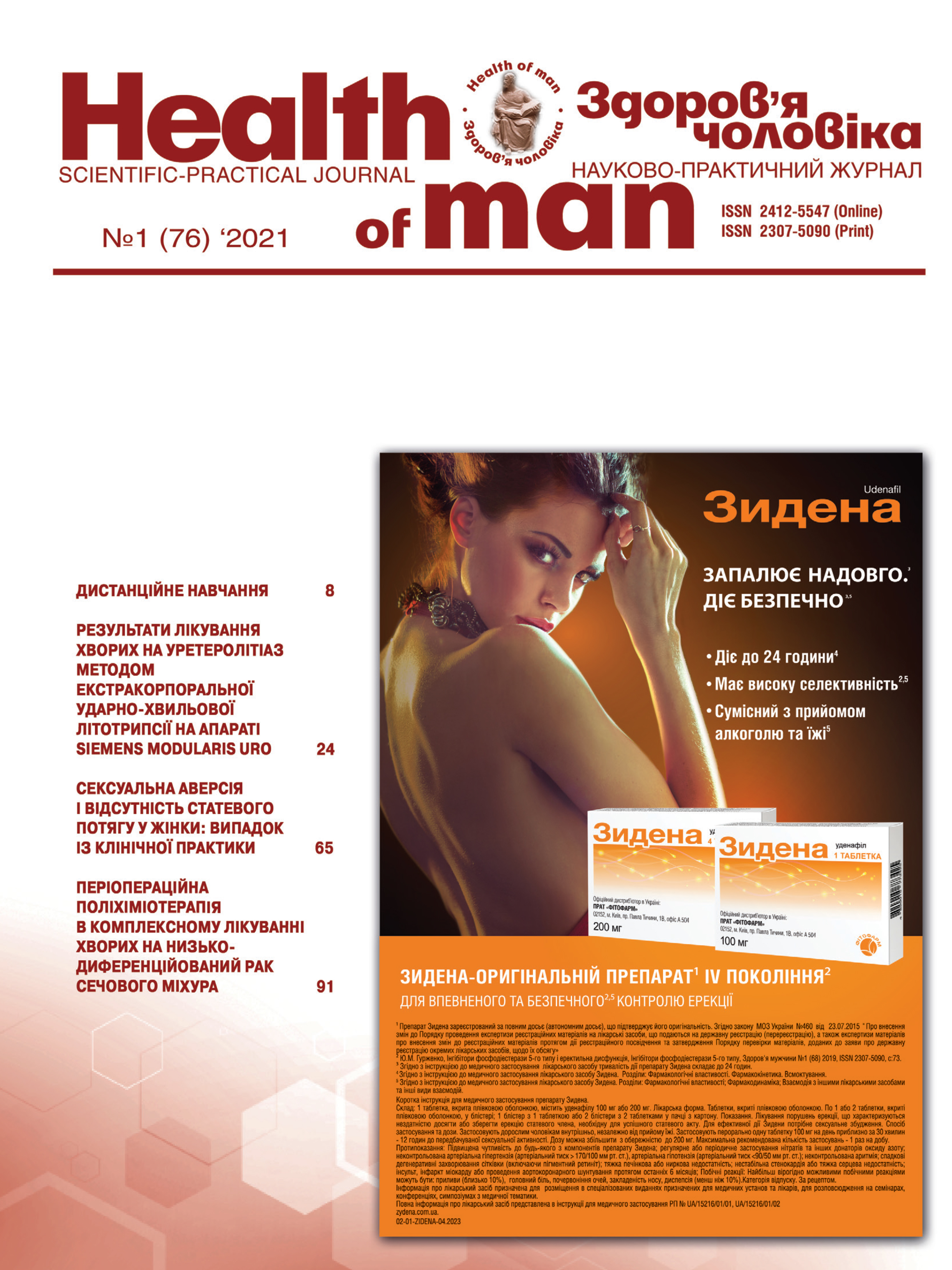Efficacy of an Herbal Preparation Based on Lovage, Rosemary, and Centaury on Patients After Extracorporal Shockwave Lithotripsy
##plugins.themes.bootstrap3.article.main##
Abstract
Study objective: to study the effect of a herbal preparation containing a standardised BNO 1040 extract* (based on lovage root, rosemary leaves and aerial parts of centaury) on the extracorporeal shockwave lithotripsy (ESWL) results in patients with urolithiasis (UL).
Methodology. 150 patients with UL (aged 18–65 years) treated with ESWL method were divided into 2 equal groups. The main group (n = 75) received standard recommendations and herbal preparation (12 months). The control group (n = 75) received standard recommendations only. The following was evaluated: time and degree of elimination of fragments; the presence of pain and leukocyturia; recurrent stone formation.
Results. The elimination of fragments was observed up to 14 days in 94.7 % of patients in the main group versus 76 % of patients in the control group. Renal colic was observed in 6.7 % of patients in the main group versus 10.7 % of patients in the control group; cases of leukocyturia were observed within 14 days in 10.7 % versus 22.7 %, respectively. During the year, a recurrent lithiasis was diagnosed in 6.7% of patients in the main group and in 16 % of patients in the control group.
Conclusion. The use of BNO 1040 extract in combination with ESWL: contributes to more rapid and safe elimination of fragments of the calculi and reduces the risk of recurrent stone formation.
##plugins.themes.bootstrap3.article.details##

This work is licensed under a Creative Commons Attribution 4.0 International License.
Authors retain the copyright and grant the journal the first publication of original scientific articles under the Creative Commons Attribution 4.0 International License, which allows others to distribute work with acknowledgment of authorship and first publication in this journal.
References
Keoghane, S., Walmsley, B., Hodgson, D. (2009). The natural history of untreated renal tract calculi. BJU international, 105(12), 1627–1629. DOI: http://doi.org/https://doi.org/10.1111/j.1464-410x.2010.09389.x.
Aliaev Yu G, Rudenko VI. Modern aspects of drug therapy of patients with urolithiasis. Effective pharmacotherapy – Urology and nephrology. 2016; 5(41):10–6.
Aliaev Yu. G., Amosov A. V., Gazimiev M. A. Ultrasound methods of functional diagnostics in urological practice. M: «R.Valent». 2010.
Cherepanova E, Dzeranov N. Metaprophylaxis of urolithiasis in ambulatory patients. Men’s Health. 2014;4(55):96–100.
Davidov MI, Igoshev AM. The effect of herbal preparation Canephron N on the results of extracorporeal shockwave lithotripsy. Men’s Health. 2015;4(55):96–100.
Ceban E. Efficacy of a fixed combination of Centaurii herba, Levistici radix and Rosmarini folium in urinary lithiasis Zeitschrift fur Phytotherapie. 2012;33(01):19–23.
Tiselius H-G, Alken P, Buck C, Gallucci M, Knoll T, Sarica K, Turk C. EAU Guedlines on urolithiasis. European Association of Urology. 2009;116.
Kok, D. J. (2015). The preventive treatment of recurrent stone-formation: how can we improve compliance in the treatment of patients with recurrent stone disease? Urolithiasis, 44 (1), 83–90. DOI: http://doi.org/https://doi. org/10.1007/s00240-015-0842-9.
Aliaev R. A herbal preparation Canephron N in the treatment of patients with urolithiasis. Urology. 2012;6:22–5.
Gaibulaev A, Kariev S. Effect of longterm Canephron N treatment on urinary risk factors associated with idiopathic calcium urolithiasis. Springer Medizin 2012.
Naber, K. (2013). Efficacy and safety of the phytotherapeutic drug Canephron N in prevention and treatment of urogenital and gestational disease: review of clinical experience in Eastern Europe and Central Asia. Research and reports in urology, 5, 39–46. DOI: http://doi.org/https://doi.org/10.2147/rru.s39288.
Grigorian V, Amosov A. The use of Canephron N in urolithiasis. Russian Medical Journal. 2011;16:1033.
Alelign, T., Petros, B. (2018). Kidney stone disease: an update on current concepts. Advances in urology, 2018, 1–12. DOI: http://doi.org/https://doi.org/10.1155/2018/3068365.
Strohmaier, W. L. (2000). VolkswirtschaftlicheAspekte des Harnsteinleidens und der Harnsteinmetaphylaxe. Der Urologe A, 39 (2), 166-170. DOI: http://doi.org/https://doi.org/10.1007/s001200050026.
Yeni, E et. al. (2003) 2 EULIS meeting (the 10-th European symposium on Urolithiasis). Istanbul, 348.
Trinchieri, A. (2006). Epidemiological trends in urolithiasis: impact on our health care systems. Urological research, 34(2), 151–156. DOI: http://doi.org/https://doi.org/10.1007/s00240-005-0029-x.
Kumarasamy, Y., Nahar, L., Sarker, S. (2003). Bioactivity of gentiopicroside from the aerial parts of Centaurium erythraea. Phytotherapy, 74 (1-2), 151–154. DOI: http://doi.org/https://doi.org/10.1016/s0367-326x(02)00319-2.
Ukhal M, Gabchak R. The use of the drug Canephron N in combination with balneotherapy in patients with urolithiasis. Men’s Health. 2010;4:117–21.
Ukhal M., Malomuzh O., (2013). Modern possibilities of phytotherapy in the postoperative rehabilitation treatment of patients with urolithiasis complicated by chronic pyelonephritis. Urology, nephrology, Andrology. Kharkov, 196–200.
Gracza, L., Koch, H., Loffler, E. (1985). Uber biochemisch-pharmakologische Untersuchungen pflanzlicher Arzneistoffe, 1. Mitt. Isolierung von Rosmarinsaure aus Symphytum officinale und ihre anti-inflammatorische Wirksamkeit in einem In-vitro-Modell. Archiv Der Pharmazie, 318 (12), 10901095. DOI: http://doi.org/https://doi.org/10.1002/ardp.19853181207.





